Employee engagement survey results & analysis in 2025: A complete guide for HRs

Imagine you’re working at a bustling tech startup. The energy is high, deadlines are tight, and everyone’s scrambling to make the next big release. But beneath the surface, cracks are forming—miscommunications, burnout, and frustrations simmering unspoken.
Then comes the company’s engagement survey. At first, it feels like just another task. But soon, you see everyone’s real thoughts laid bare: calls for better work-life balance, clearer goals, and more recognition.
Management takes notice, rolling out targeted changes and opening channels for ongoing feedback. Morale starts to lift, collaboration improves, and that once chaotic startup transforms into a supportive powerhouse. This is the power of acting on engagement survey results—turning candid feedback into a better workplace for everyone.
TL;DR
What are employee engagement survey results?
TL;DR
Employee engagement survey results reflect employees’ perceptions of their workplace, culture, leadership, and job satisfaction.
They provide insights into motivation, concerns, and strengths, helping organizations identify improvement areas and track progress toward fostering a more engaged, productive, and satisfied workforce.
Employee engagement survey results reflect how employees perceive their work environment, company culture, leadership, and more. By collecting and analyzing this feedback, companies can make informed decisions to enhance employee satisfaction and productivity.
These results offer critical insights into employee morale, revealing levels of motivation, job satisfaction, and workplace stress. They also help identify cultural trends and recurring patterns, providing a clear view of organizational strengths and cultural gaps.
Survey results pinpoint barriers to engagement, such as a lack of recognition, unclear growth paths, or poor communication, helping management prioritize areas for improvement. Tracking these results over time allows organizations to measure the impact of engagement initiatives and identify what still needs work.
Sharing survey outcomes with employees and demonstrating follow-up actions promotes transparency, accountability, and a sense of ownership in workplace culture, fostering trust and reinforcing the company’s commitment to positive change. Engaging meaningfully with these results ultimately empowers teams and drives a more connected, engaged, and productive workforce.



Highly engaged employees make the customer experience. Disengaged employees break it.
Founder
LeaderFactor
Importance of analyzing employee engagement data
Analyzing employee engagement results data is crucial for understanding and improving workplace dynamics. Here’s why this analysis matters:
- Identifying root causes of low engagement: A detailed analysis uncovers the deeper reasons behind disengagement, such as ineffective leadership, a lack of career growth, or unaddressed stressors, allowing targeted interventions.
- Segmenting data for precision: Breaking down engagement data by departments, roles, tenure, or locations provides a granular view of which areas are thriving and which need focused improvement, ensuring tailored solutions rather than a one-size-fits-all approach.
- Predicting turnover risks: High engagement correlates with employee retention. Analyzing data helps identify groups at risk of leaving, giving organizations a chance to proactively address concerns and retain talent.
- Measuring the impact of initiatives: Engagement initiatives often require significant investment. Data analysis assesses their effectiveness, helping leaders determine what strategies drive real improvement and which need adjustment.
- Aligning organizational goals and employee needs: By linking engagement data with business goals, leaders can ensure organizational priorities align with employees’ aspirations, increasing buy-in and motivation.
- Driving continuous improvement: Engagement data is dynamic, reflecting the changing workplace climate. Regular analysis fosters a culture of continuous feedback and adaptation, ensuring the organization evolves in line with employee expectations.
Types of employee engagement survey results
Employee engagement survey results offer a wealth of data that, when properly categorized, provide deep insights into organizational dynamics and areas of improvement. Here are the primary types to consider:
- Quantitative results: These results provide numerical data from closed-ended questions, often presented in the form of scores, percentages, or ratings. Quantitative data is ideal for identifying trends, benchmarking performance, and measuring overall engagement levels within the organization.
- Qualitative feedback: Open-ended responses offer rich, detailed employee perspectives that go beyond numerical scores. This type of feedback helps uncover the "why" behind scores, giving deeper context to employee sentiments, concerns, and suggestions for improvement.
- Trend data: Trend data tracks engagement levels over time, highlighting patterns or changes in employee sentiment. These results help organizations assess the effectiveness of past initiatives and understand whether engagement levels are improving, declining, or remaining stable.
- Benchmark comparisons: Survey results compared against industry benchmarks or past company data offer a point of reference to assess relative performance. Benchmarking provides context, helping organizations determine how they stack up within their industry or identify progress over time.
- Demographic-specific results: This data breaks down engagement scores by specific groups, such as departments, locations, roles, or tenure. Demographic-specific insights highlight areas of strength and pinpoint where focused interventions may be needed.
- Engagement drivers: This category identifies factors that most influence engagement within the organization, such as leadership quality, recognition, career growth opportunities, or work-life balance.
What is the goal of employee engagement survey analysis?
The goal of employee engagement survey analysis is to translate employee feedback into meaningful action that improves workplace culture and drives organizational success. Here are the key objectives of this analysis:
TL;DR
The goal of employee engagement survey analysis is to turn employee feedback into actionable strategies that improve workplace culture and boost engagement. It helps identify trends, prioritize key areas for improvement, and measure the effectiveness of initiatives over time.
This alignment of organizational goals with employee needs fosters trust, motivation, and a culture of continuous improvement.
- Uncover hidden patterns: Analysis helps identify trends or recurring issues that may not be immediately apparent. Hidden patterns can offer valuable insights into systemic problems or highlight cultural strengths that can be leveraged.
- Prioritize improvement areas: Not all issues hold equal importance. Analysis allows organizations to rank engagement factors based on their impact, focusing resources and efforts on areas that drive the most significant change.
- Understand team-level variations: Employee engagement varies across departments or teams. Analyzing data at a micro-level reveals group-specific challenges and opportunities, leading to tailored strategies for improvement.
- Measure the ROI of initiatives: Evaluating past engagement initiatives through survey analysis enables companies to measure their return on investment and refine or scale successful strategies.
- Foster employee-centric decision-making: Using survey insights in strategic planning shows a commitment to employees’ voices, building trust, and aligning organizational goals with their needs.
- Create a feedback loop: Regularly analyzing and acting on survey data establishes an ongoing cycle of feedback and improvement, maintaining a culture of open communication and continuous development.
What are the key metrics and indicators in employee engagement survey results?
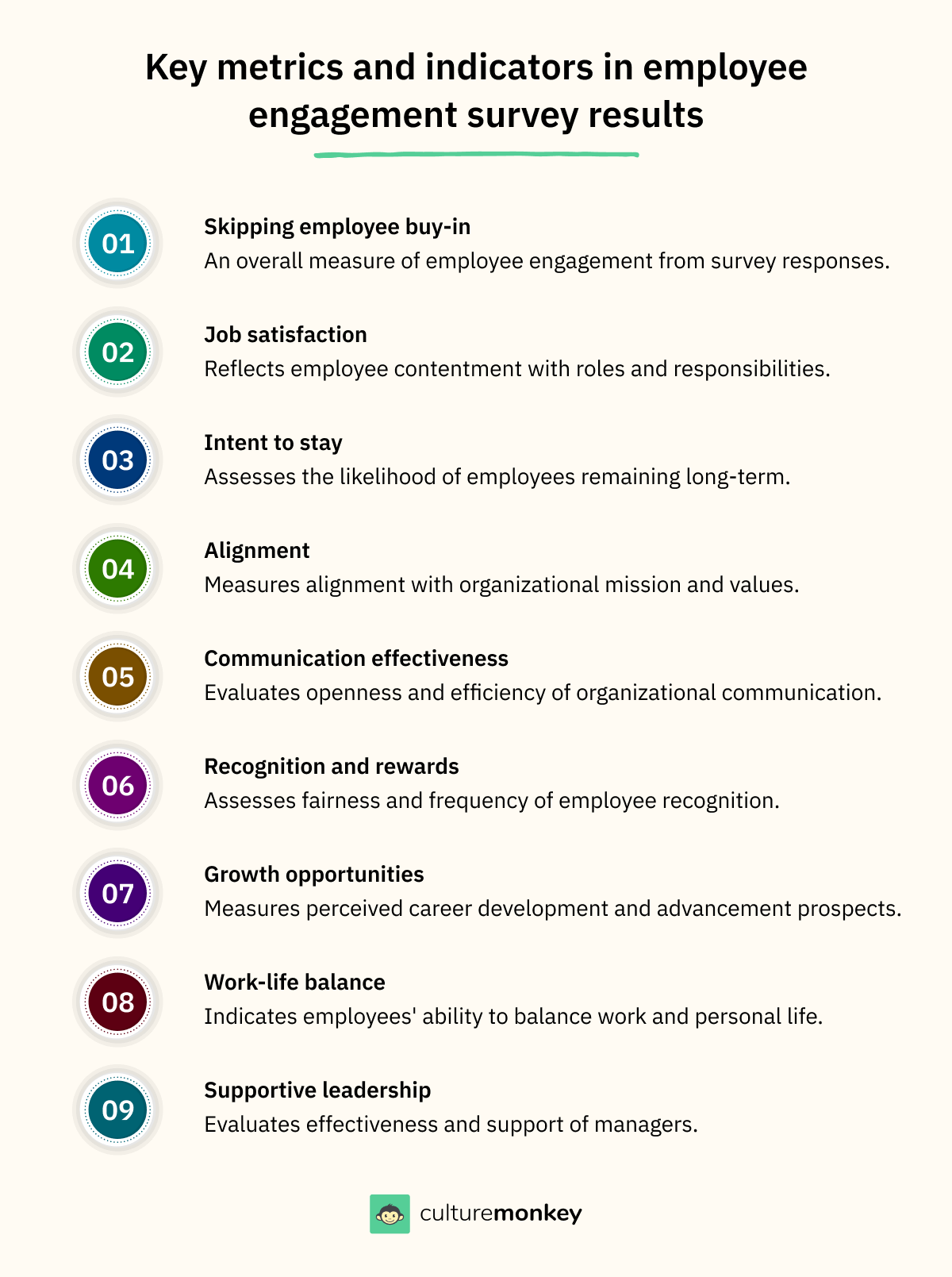
Employee engagement survey results provide valuable data through various key metrics and indicators that offer insights into the overall engagement levels within an organization. Some of the key metrics and indicators commonly found in these surveys include:
- Engagement score: An overall measure of employee engagement, usually calculated based on responses to multiple survey questions.
- Job satisfaction: Indicates how content employees are with their roles, responsibilities, and the work they perform.
- Intent to stay: Measures the likelihood of employees staying with the company for the long term.
- Alignment with company values: Assess how well employees believe their values align with the organization's mission and values.
- Communication effectiveness: Evaluate the efficiency and openness of communication within the organization.
- Recognition and rewards: Measures the perception of employees regarding the fairness and frequency of recognition and rewards for their efforts.
- Growth opportunities: Assess whether employees feel they have sufficient opportunities for career development and advancement.
- Work-life balance: Indicates the extent to which employees can maintain a healthy balance between work and personal life.
- Supportive leadership: Measures the effectiveness and supportiveness of immediate supervisors or managers.
- Teamwork and collaboration: Assesses the level of cooperation and teamwork within departments and across the organization.
- Employee empowerment: Evaluates the extent to which employees feel empowered to make decisions and contribute ideas.
- Pride in the organization: Measures the level of pride employees feel for being part of the organization.
- Employee well-being: Assesses the overall well-being of employees, including physical, emotional, and mental health.
- Diversity and inclusion: Measures the extent to which employees feel the organization promotes diversity and inclusion.
Common challenges in interpreting employee engagement survey results
Interpreting employee engagement survey results can present various challenges that organizations need to be aware of to ensure accurate and meaningful insights. Some common challenges include:
- Ambiguous responses: Employees may provide vague or unclear answers, making it difficult to gauge their true sentiments or motivations. This often occurs when questions are too broad or lack specificity, highlighting the need for precise survey design and follow-up clarifications.
- Response bias: Some employees may withhold their honest opinions due to fear of retaliation, social desirability, or other factors. This creates skewed data that may not accurately reflect employee sentiment, underscoring the importance of confidentiality and trust-building.
- Benchmarking difficulties: Comparing results against industry standards can be challenging due to variations in survey methods and company structures. Tailoring benchmarks to organizational realities ensures more relevant comparisons.
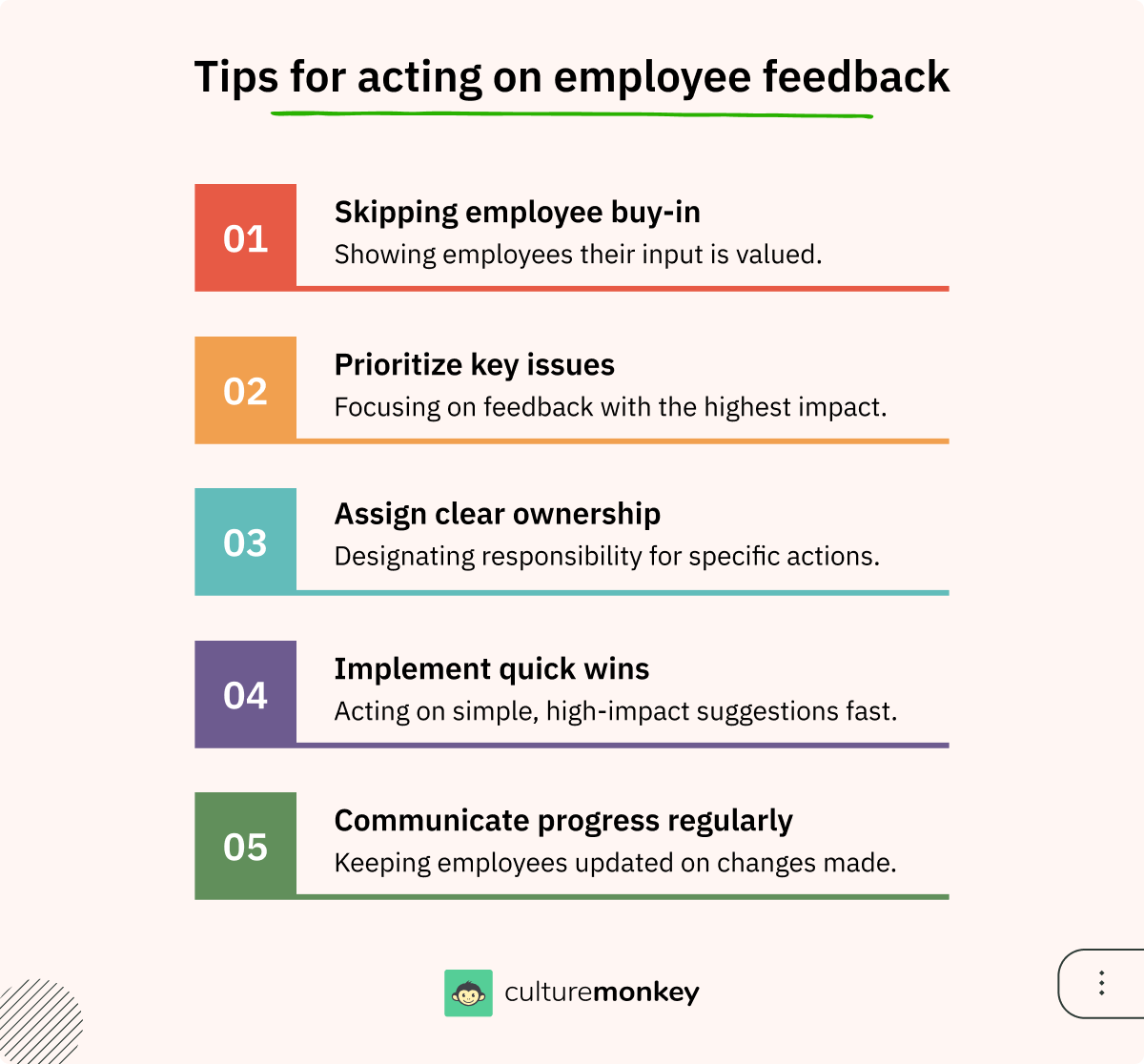
- Identifying actionable insights: Translating raw survey data into specific, targeted improvements requires in-depth analysis and prioritization, emphasizing the need for skilled interpretation and focused solutions.
- Change in employee sentiments: Engagement levels can fluctuate based on internal and external factors. Regularly conducting surveys helps track these shifts and adjust initiatives accordingly to stay aligned with evolving needs.
- Overemphasis on scores: Focusing only on engagement scores without exploring the underlying causes may result in ineffective or superficial action plans. Delving into root drivers ensures meaningful improvements.
- Interpreting open-ended responses: Analyzing qualitative data can be labor-intensive and subjective, but it offers rich insights into employee perspectives. Using advanced text analytics tools or expert review can improve interpretation.
- Survey fatigue: Overly frequent surveys can lead to disengagement and reduced response quality. Implementing a strategic survey schedule with thoughtful timing and relevance helps maintain interest and participation.
- Inadequate communication: Failing to share survey results and follow-up actions with employees undermines trust and diminishes the perceived impact of their feedback. Transparent communication builds credibility and shows commitment to meaningful change.
Templates to report employee engagement survey findings effectively
An employee engagement survey results template helps you present findings clearly and consistently. Here are the key components to include:
- Executive summary: A high-level overview of the employee engagement survey results, highlighting the overall engagement score and key takeaways.
- Benchmark comparison: Show how your results stack up against previous surveys, industry benchmarks to define what is a good employee engagement score.
- Employee satisfaction survey results: Include separate metrics for satisfaction to complement engagement insights and provide a fuller picture.
- Segmented data: Break down employee survey results by department, role, tenure, or location to uncover deeper insights.
- Qualitative feedback summary: Highlight common themes from open-ended responses, showcasing employee feedback in employees’ own words.
- Visuals and charts: Use graphs, tables, or slides to make your employee engagement survey results presentation or employee engagement report easy to digest.
- Action plan outline: Summarize the next steps from your employee survey results action plan, with clear priorities and timelines.
- Follow-up plan: Indicate how progress will be tracked and communicated, reinforcing trust and accountability.
- Acknowledgment of anonymity: Reassure employees their feedback, collected via anonymous survey feedback tools, remains confidential.
Pitfalls to avoid when interpreting employee engagement data
While employee engagement survey results offer valuable insights, missteps in interpretation can lead to flawed decisions and disengagement. Here are common pitfalls to avoid:
TL;DR
When interpreting employee engagement data, avoid relying solely on overall scores, as they can mask team-level issues and underlying causes. Ignoring qualitative feedback or delaying communication can undermine trust and lead to ineffective actions.
Focus on context, transparency, and clear insights instead of overcomplicating data or ignoring anonymous feedback to drive real improvements and trust.
- Focusing only on the overall employee engagement score: The overall score provides a high-level view, but it can mask specific issues. Always dig into segmented employee survey results by team, role, or location for actionable insights.
- Ignoring employee satisfaction survey results: Engagement and satisfaction are related but distinct. Overlooking employee satisfaction survey results can mean missing critical signals about morale and retention risks.
- Overlooking qualitative feedback: Numbers tell part of the story. Ignoring open-ended comments and interpreting employee feedback superficially prevents you from understanding root causes.
- Failing to benchmark: Without comparing your results to benchmarks — such as Gallup employee engagement survey results — you risk misjudging what is a good employee engagement score for your industry or size.
- Delaying communication of results: Employees expect timely feedback. Postponing your employee engagement results presentation can erode trust and dampen enthusiasm.
- Lack of transparency in sharing results: Trying to downplay or hide low scores damages credibility. Knowing how to communicate employee engagement survey results honestly and constructively is crucial.
- Neglecting an action plan: Interpreting survey results and action planning must go hand in hand. Presenting data without outlining next steps makes employees feel unheard.
- Focusing only on weaknesses: While it’s essential to improve engagement survey scores, overlooking strengths risks demotivating already high-performing teams.
- Disregarding anonymous feedback: Anonymous survey feedback tools encourage honesty. Discounting candid comments because they’re anonymous undermines trust in the process.
- Overcomplicating the presentation: A cluttered or overly technical employee engagement survey results presentation can confuse audiences. Use an employee engagement survey results template or employee engagement survey results presentation to keep messaging clear.
Engaging your team in survey results discussions
Discussing employee survey results with your team is a critical step in fostering engagement and trust. Here are key do's and don’ts to consider:
| Behavior | Do's | Don’ts |
|---|---|---|
| Preparation | Review data thoroughly, understand key insights, and come prepared to discuss meaningful findings. | Come unprepared, or overlook sensitive issues, which can signal lack of respect for feedback. |
| Environment | Create a safe, judgment-free space for employees to share openly, focused on improvement. | Create a tense or critical atmosphere that discourages honesty and trust. |
| Focus | Highlight key themes and patterns, avoiding excessive detail that may single out individuals. | Dive into granular data that targets specific individuals or irrelevant points. |
| Transparency | Share both positive and negative results honestly, acknowledging challenges and celebrating successes. | Sugarcoat findings, hide issues, or focus only on the positives. |
| Responses to feedback | Listen actively without defensiveness, and seek to understand concerns before responding. | Argue, justify, or dismiss negative feedback. |
| Commitments | Make realistic promises you can follow through on to maintain credibility. | Make empty or unrealistic commitments that you cannot keep. |
| Perspectives | Acknowledge diverse viewpoints for a fuller understanding of the team’s experience. | Assume one or two comments represent everyone’s experience. |
| Pacing | Allow time for questions, input, and thoughtful reflection during the discussion. | Rush through the conversation, making employees feel unheard. |

Engagement that reflects results
Turn employee survey insights into engaging team activities designed to boost morale, foster connection, and drive meaningful engagement.
What is a good employee engagement score?
A good employee engagement score typically falls within the range of 70% to 85%. This means that 70% to 85% of employees are actively engaged and satisfied with their work and the organization. However, the ideal score may vary based on industry benchmarks and organizational goals.
An engagement score below 70% indicates potential issues with employee satisfaction and commitment, requiring attention and improvement strategies. Conversely, scores above 85% suggest a highly engaged workforce, which can lead to increased productivity, reduced turnover, and better overall performance.
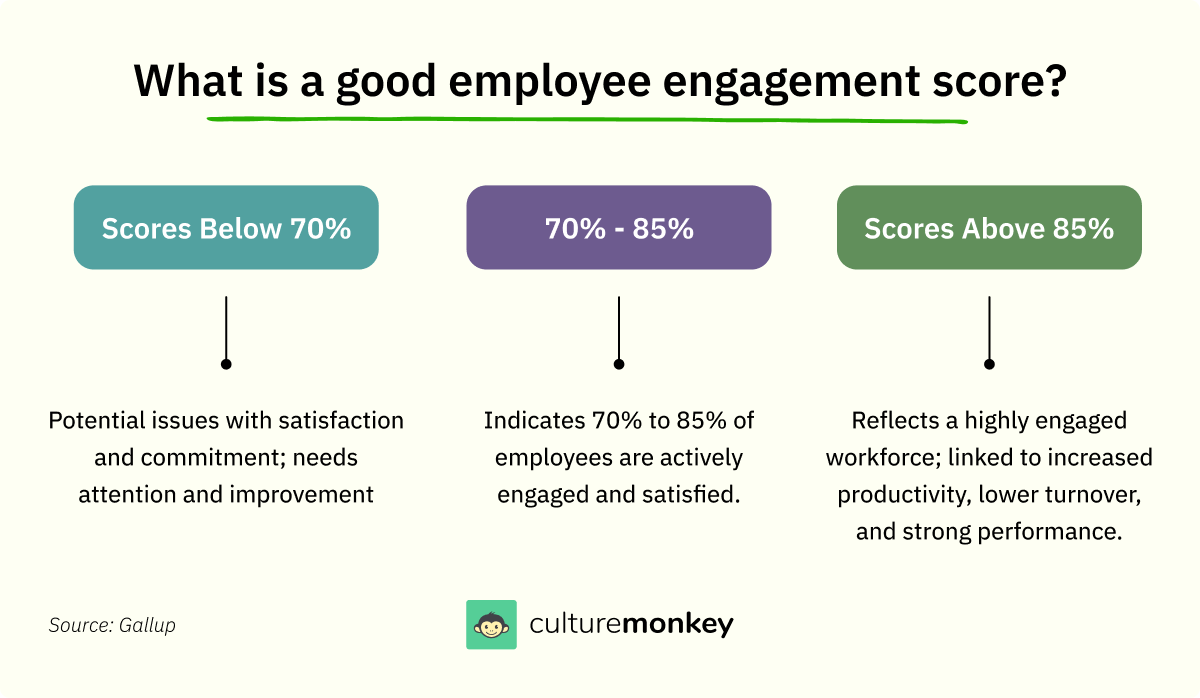
It's essential to note that the interpretation of the engagement score should not be limited to a single number. Organizations must also consider specific drivers of engagement, identified through the survey, to implement targeted interventions and foster a positive work environment.
Employee engagement survey result benchmarks by industry
Comparing your employee engagement survey results to industry benchmarks helps you understand what is a good employee engagement score for your sector. Here are common benchmarks, with data-backed sources:
- Professional services: Engagement scores here tend to be above average, driven by clear career paths and strong cultures. For example, Gallup reports professional services firms often score ~77% engaged, above the global average of ~70%.
- Healthcare: According to HBR, engagement scores lag by approximately 10–15% versus global averages, primarily due to burnout and chronic stress.
- Retail and hospitality: HBR highlights that healthcare engagement scores lag 10–15% below average, largely because of burnout and chronic stress
- Manufacturing: Industry Week cites Gallup to show that only about 25% of manufacturing employees feel engaged—the lowest across major industries—highlighting persistent challenges.
- Financial services: Gallup states that engagement tends to be strong, around 72–75%, but qualitative feedback often highlights work-life balance challenges.
The role of anonymity and honesty in interpreting results
Anonymity and honesty are essential for collecting meaningful employee engagement survey results that truly reflect employee sentiment. Here’s how these factors influence the way results should be interpreted and acted upon:
- Encouraging candid feedback: Anonymous survey feedback tools give engaged employees the confidence to express their true feelings without fear of retaliation. This results in more accurate and actionable employee survey results.
- Improving the quality of data: Employees are more likely to respond honestly to employee engagement survey questions when they know their identities won’t be revealed, leading to better employee satisfaction survey results and more reliable insights.
- Building trust in the process: Communicating that responses are confidential increases participation and trust in future surveys, which strengthens your HR feedback analysis efforts over time.
- Interpreting employee feedback contextually: Honest feedback can sometimes be blunt or critical. Interpreting employee feedback with empathy and an understanding of anonymity ensures comments are viewed as opportunities rather than complaints.
- Designing effective follow-up plans: When honesty and anonymity are preserved, your survey follow-up plan can be more targeted and credible, directly addressing real employee concerns and helping improve engagement survey scores.
- Enhancing action planning: Using anonymous feedback as part of your employee survey results action plan ensures that even sensitive issues are addressed, which can raise the overall employee engagement score in future surveys.
- Reporting with transparency: Even though responses are anonymous, sharing trends, themes, and action steps transparently in your employee engagement survey results presentation reassures employees their feedback is being heard and valued.
Identifying positive trends to interpret engagement improvements
Identifying positive trends in employee engagement is crucial for organizations to understand the effectiveness of their efforts in enhancing employee satisfaction and commitment. When interpreting improvements in engagement, several key factors need to be considered:
- Trend analysis: Analyze engagement survey results over multiple periods to identify consistent positive trends. A sustained increase in engagement scores indicates genuine improvements.
- Specific areas: Focus on the areas where engagement has improved the most. Identify the drivers that contributed to these positive changes, such as better communication, enhanced recognition programs, or improved work-life balance.
- Employee feedback: Review qualitative feedback from employees to gain deeper insights into the reasons behind the improvements. Positive comments can highlight successful initiatives and employee satisfaction drivers.
- Impact on performance: Examine how improved engagement correlates with key performance indicators, such as increased productivity, reduced absenteeism, and higher retention rates.
- Comparisons: Compare current engagement scores with previous years or industry benchmarks to gain a broader perspective on the positive trends and determine the organization's relative performance.
- Alignment with initiatives: Assess whether the positive trends align with specific initiatives or changes implemented in the organization. This helps identify which strategies are most effective in driving engagement.
- Managerial influence: Investigate the role of effective leadership and management practices in contributing to improved engagement. Recognize managers who fostered positive changes in their teams.
- Impact on culture: Consider how improved engagement impacts the overall organizational culture. Positive trends may reflect a more inclusive, supportive, and positive work environment.
- Employee advocacy: Monitor whether increased engagement leads to higher rates of employee advocacy and referrals, indicating a positive perception of the organization as a great place to work.

Ask the questions that count
Gather valuable insights to boost employee engagement and drive meaningful workplace improvements.
Recognizing and overcoming bias in employee survey interpretation
Interpreting employee survey results requires careful attention to potential biases that can distort insights and hinder effective decision-making. Here are common examples of biases to watch for:
- Confirmation bias: This occurs when leaders selectively interpret data that aligns with their preconceived beliefs or expectations. To avoid this, consider all perspectives and challenge assumptions by exploring contradictory findings.
- Recency bias: Giving more weight to recent events, such as a project’s success or a conflict, can skew interpretations. Analyzing data over time and focusing on overall trends helps mitigate this bias and presents a more balanced view.
- Selection bias: Results may be skewed if participation isn’t representative of the entire workforce. For example, if mostly engaged employees respond, their input may not capture broader organizational issues. Ensure broad participation to capture diverse viewpoints.
- Attribution bias: This occurs when leaders attribute engagement scores solely to employee attitudes, ignoring external factors like workload spikes or organizational changes. Consider the broader context to avoid misplaced conclusions.
- Halo effect: Positive performance in one area may lead to overly favorable interpretations in unrelated areas. To prevent this, assess each survey dimension independently for a comprehensive view.
- Social desirability bias: Employees may provide responses they believe are expected or viewed favorably rather than sharing their true feelings. Anonymity and a safe feedback environment reduce this bias, enhancing authenticity.
6 Steps for responding to employee survey results
Responding effectively to employee survey results is crucial to fostering engagement, trust, and a culture of continuous improvement. Here are six steps for responding:
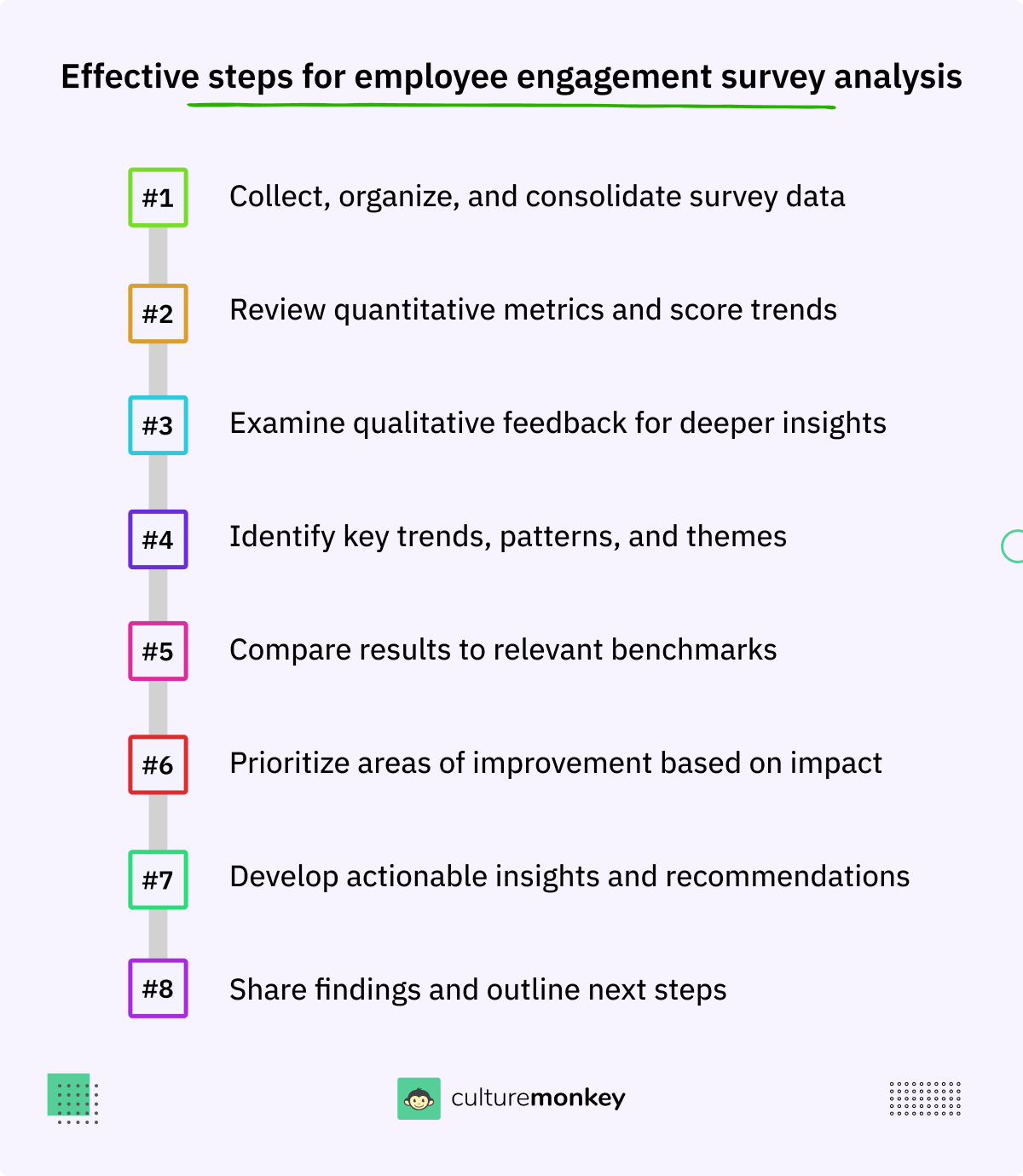
- Acknowledge and share results: Start by communicating the survey findings to employees transparently. Summarize key insights and show that their feedback has been reviewed and valued. This step builds trust and demonstrates organizational commitment.
- Analyze data for root causes: Dig deeper into survey results to understand the underlying issues, trends, or patterns. Identify the causes driving specific feedback rather than addressing symptoms alone to ensure meaningful solutions.
- Prioritize areas of focus: Not all issues can be tackled at once. Prioritize the key areas with the most significant impact on employee engagement and business outcomes. This ensures efficient use of resources and maximizes improvements.
- Develop targeted action plans: Create tailored strategies that address specific issues. Collaborate with relevant teams or departments to design clear, actionable steps and set measurable goals to track progress.
- Involve employees in solutions: Invite employees to participate in developing and implementing solutions. Employee involvement ensures buy-in, practicality, and relevance of the initiatives, fostering a sense of ownership.
- Communicate progress and next steps: Regularly update employees on the status of action plans. Share milestones, successes, and remaining challenges to reinforce transparency and demonstrate continued commitment to their feedback.
Employee survey results communication examples
Effectively communicating employee survey results is key to building trust, fostering transparency, and driving engagement initiatives. Here are examples of best practices for sharing survey results:
- All-hands meeting: Hold a company-wide meeting to share survey findings, highlighting key themes, trends, and immediate actions. This format shows leadership's commitment to transparency and enables open Q&A, promoting a culture of inclusion.
- Departmental presentations: Tailor results presentations for each department, focusing on specific insights relevant to their team. This personalized approach shows employees that their input is valued and fosters accountability at the local level.
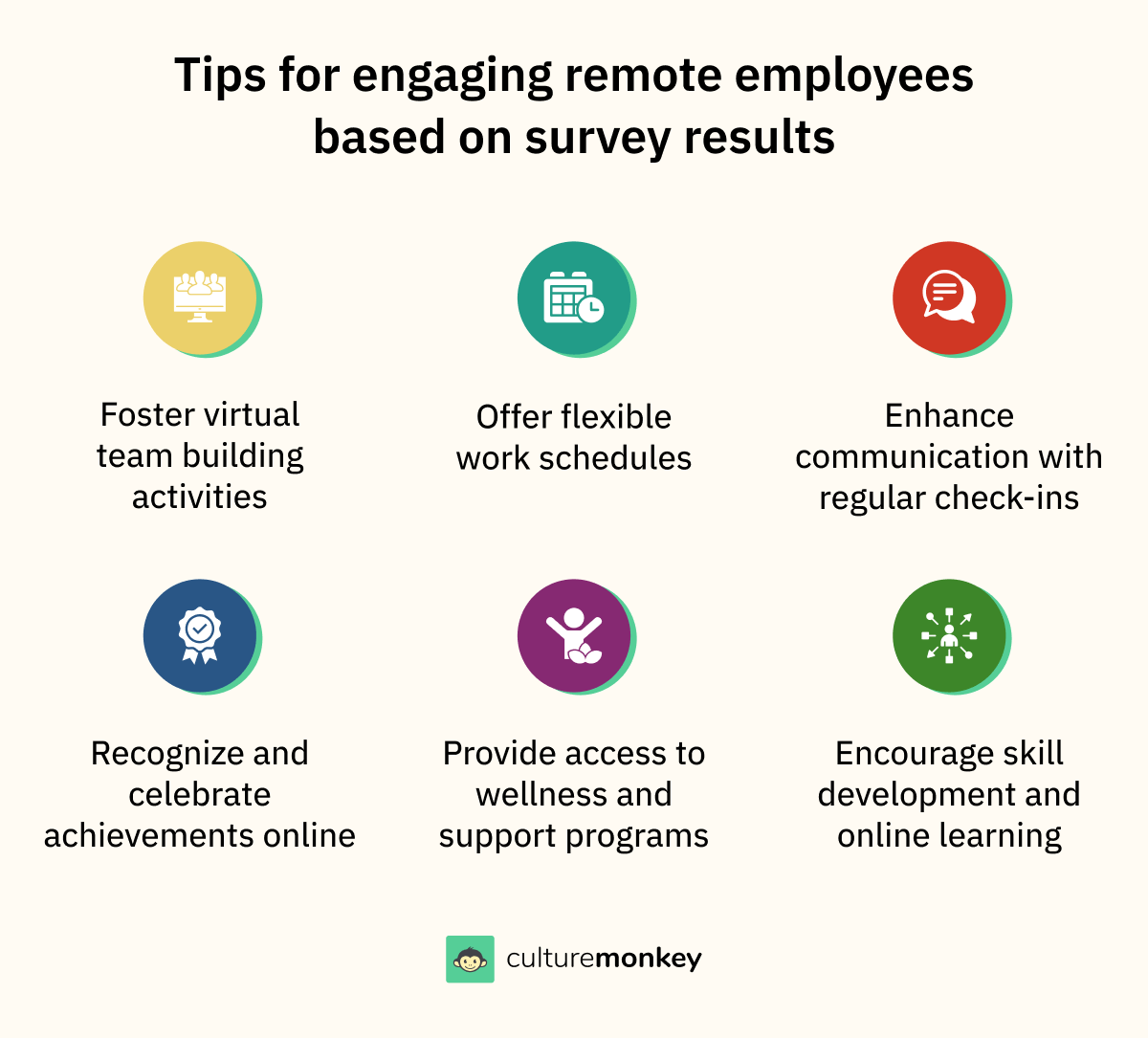
- Visual reports and infographics: Create easy-to-understand visual summaries, such as infographics or dashboards, to present survey results. These visuals make complex data more accessible, engaging, and impactful for employees.
- CEO video message: A video message from senior leadership sharing survey highlights, key takeaways, and planned next steps adds a personal touch and reinforces leadership’s commitment to action.
- Follow-up emails: Use concise follow-up emails to summarize survey outcomes, outline planned initiatives, and provide a timeline for next steps. This keeps employees informed and reassures them of the organization’s dedication to improvement.
- Feedback forums: Host forums or listening sessions where employees can discuss results and offer further input on proposed actions. These forums help validate survey findings and engage employees in the improvement process.
How to segment survey results for deeper insights
Segmenting employee engagement survey results helps uncover patterns and address specific needs effectively. Here are the key ways to segment your data to form an employee engagement strategy:
- By department or team: Identify which teams have higher or lower engagement scores and tailor action plans accordingly.
- By tenure or experience level: Compare employee satisfaction survey results between new hires and seasoned employees to spot onboarding or retention issues.
- By location or region: Highlight geographic trends to address region-specific concerns reflected in employee survey results.
- By role or job function: Understand how engagement varies between managers, frontline staff, and executives for targeted initiatives.
- By demographics: Where appropriate, segment by age, gender, or other factors to ensure inclusivity while maintaining anonymity with anonymous survey feedback tools.
- By performance level: Show the employee engagement data interpretation to team or individual performance to identify success drivers.
- Over time: Review segmented data from past surveys to track trends and measure the impact of your employee survey results action plan.
How to link survey results to business outcomes
Connecting employee engagement survey results to tangible business outcomes helps justify investments in engagement initiatives and shows the value of acting on feedback. Here’s how to analyze survey results and make the link clear and actionable:
- Compare engagement scores to business KPIs: Track how your employee engagement score correlates with productivity, customer satisfaction, or revenue. Gallup employee engagement survey results highlight these links.
- Use satisfaction results to predict retention: Lower employee satisfaction survey results often signal higher turnover, which can be costly.
- Segment results for team-level impact: Analyze employee survey results by team to see where engagement drives better performance or service quality.
- Include business metrics in your presentation: In your employee engagement results presentation, show how improvements align with measurable business gains.
- Plan actions tied to outcomes: Align your employee survey results action plan with goals like improving retention, sales, or customer experience.
- Showcase wins in reporting: Use your employee engagement survey results template or presentation to highlight past improvements tied to business results.
Why employee engagement results alone don’t tell the full story
Employee engagement survey results are a valuable metric, but relying on them alone can lead to incomplete conclusions. Here’s why you need a broader perspective:
- They don’t explain the ‘why’: Employee engagement scores show what employees feel, but interpreting employee feedback is key to uncovering the reasons behind the scores.
- They miss business context: Engagement data often lacks direct connections to business KPIs, making it hard to link employee survey results to analyze survey results like retention or productivity.
- They overlook satisfaction and sentiment: Employee satisfaction survey results and qualitative comments provide additional insight into employee input, morale and emotional drivers.
- They can mask team-level variation: High overall engagement can hide low scores in specific teams, which only segmentation of employee survey results can reveal.
- They may reflect short-term sentiment: Engagement surveys capture a moment in time; ongoing HR feedback analysis and a survey follow-up plan are needed to track trends.
- They don’t measure action effectiveness: Without reviewing progress through employee engagement reporting tools, it’s hard to know if your employee survey results action plan is working.
- They risk ignoring anonymity concerns: If employees doubt the anonymity of anonymous survey feedback tools, they may not respond honestly, skewing results.
What to do with engagement survey results
Collecting employee engagement survey results is just the beginning — what you do next determines the real impact. Here’s how to turn results into meaningful action:
TL;DR
After collecting engagement survey results, analyze data deeply to uncover key themes, segment insights, and benchmark performance against industry standards.
Communicate findings transparently, create a clear action plan with measurable goals, and follow up regularly to show progress. This builds trust, addresses concerns effectively, and fosters a more engaged and motivated workforce.
- Analyze the data thoroughly: Go beyond the overall employee engagement score by segmenting results and reviewing employee satisfaction survey results for detailed insights.
- Interpret feedback with context: Combine quantitative data and qualitative comments to fully understand employee concerns and sentiments.
- Benchmark your results: Compare your scores to industry averages to assess where you stand and what is a good employee engagement score.
- Prepare a clear results presentation: Create an employee engagement survey results presentation or employee engagement report to share findings with leadership and employees in an understandable way.
- Communicate findings transparently: Explain what you learned, both the positives and areas for improvement, using anonymous survey feedback tools to protect privacy and build trust.
- Develop an action plan: Use your employee survey results action plan to prioritize initiatives that address the most critical issues and improve engagement survey scores over time.
- Set measurable goals: Tie actions to specific outcomes, such as reducing turnover, improving satisfaction, or boosting team performance.
- Monitor progress: Use employee engagement reporting tools to track improvements and adjust strategies as needed.
- Follow up regularly: Reinforce trust by checking back with employees through pulse surveys and updating them on progress as part of your survey follow-up plan.

Make results matter
Use employee engagement results to create targeted strategies that drive impactful and lasting workplace improvements.
Turning survey results into meaningful strategies
By creatively translating survey result strategies, organizations can nurture a thriving and engaged workforce, ultimately leading to improved performance and employee satisfaction.
- Employee engagement champions: Identify and appoint employees from different departments as "Engagement Champions." Their role is to act as advocates for employee engagement initiatives, share success stories, and foster a positive work culture.
- Culture-driven competitions: Organize engaging competitions that align with the organization's values and goals. For example, a creativity contest to encourage innovative thinking or a community service challenge to promote a sense of purpose and social responsibility.
- Managerial shadowing: Initiate a cross-departmental managerial shadowing program, where employees spend a day observing and learning from different managers. This promotes collaboration, empathy, and a better understanding of leadership styles.
- Flex-work festival: Host a "Flex-Work Festival" week, allowing employees to experiment with flexible work arrangements. This demonstrates trust and empowers employees to find work-life balance solutions that suit their needs.
- Feedback Olympics: Conduct a "Feedback Olympics" to encourage constructive feedback culture. Employees earn medals for providing valuable feedback to their peers and managers, fostering a culture of open communication.
- Engagement adventure map: Create an "Engagement Adventure Map" that outlines a journey for employees to explore various engagement initiatives, like training sessions, team-building events, and mentoring programs.
- Innovation incubator: Set up an "Innovation Incubator" where employees can submit innovative ideas. Recognize and support the development of promising ideas, driving a culture of continuous improvement.
- Recognition rendezvous: Host a surprise "Recognition Rendezvous" where senior leaders personally acknowledge and appreciate the outstanding contributions of employees, emphasizing the importance of recognition.
- Engagement 360° feedback: Introduce a 360-degree feedback mechanism for employee engagement initiatives. Collect feedback from employees, managers, and leaders to gain holistic insights and identify improvement areas.
- Gratitude graffiti walls: Place gratitude graffiti walls in common areas, where employees can write messages of appreciation for their colleagues, fostering a sense of camaraderie and positivity.
Sharing survey results with transparency and empathy
Communicating employee engagement survey results thoughtfully is just as important as collecting the data. Transparent, empathetic communication builds trust and sets the stage for meaningful action. Here’s how to share survey results effectively:
- Communicate employee engagement survey results clearly: Share the key findings in an accessible way. Use an employee engagement survey results presentation or a concise employee engagement report to explain the overall engagement score, major themes, and next steps.
- Acknowledge employee feedback respectfully: Employees invest time and honesty when completing surveys. Interpreting employee feedback with empathy and acknowledging their concerns shows you value their input.
- Highlight employee satisfaction survey results: Recognize areas where employees are happy and satisfied. This reinforces positive behaviors and helps maintain morale.
- Be honest about challenges: Transparency means not hiding low engagement scores or difficult feedback. Sharing what to do with engagement survey results, including areas that need improvement, demonstrates integrity.
- Frame the results with action in mind: Use an employee survey results action plan to show how feedback translates into initiatives. This helps employees see their voices lead to change and improves future engagement survey scores.
- Tailor the message to your audience: Managers may need detailed employee engagement survey analysis, while employees benefit from a high-level employee engagement results presentation with clear, relatable examples.
- Provide a follow-up plan: Announce a survey follow-up plan that outlines next steps, timelines, and accountability. This reinforces your commitment to act on the results.
- Leverage templates and reporting tools: Use an employee engagement survey results template or employee engagement reporting tools to ensure the message is consistent and easy to understand.
- Maintain anonymity and trust: Reassure employees that anonymous survey feedback tools protect their privacy. This encourages candid feedback in future surveys and strengthens trust in HR feedback analysis processes.
How to improve engagement survey scores
Improving engagement survey scores starts with actionable insights and sustained effort. Here are proven strategies to lift employee engagement survey results over time:
- Act on employee survey results quickly: Employees expect their feedback to create positive change. Creating and sharing an employee survey results action plan soon after the survey shows you’re serious about improvement.
- Communicate results with clarity and empathy: How you communicate employee engagement survey results matters. A transparent employee engagement results presentation reassures employees that their voices were heard.
- Focus on key drivers of engagement: Use employee engagement survey analysis to pinpoint specific areas — such as recognition, leadership, or career development — that are pulling down the employee engagement score.
- Empower managers with insights: Equip managers with team-level employee survey results and an employee engagement survey results template to help them have meaningful follow-up conversations with their teams.
- Celebrate successes and highlight employee satisfaction survey results: Acknowledge and reinforce what’s already working well to sustain high-performing areas.
- Benchmark and set realistic goals: Compare your engagement survey results to benchmarks like industry standards to define what a good employee engagement score for your organization.
- Provide training and resources for improvement: Use employee engagement reporting tools to track progress and offer managers training on interpreting employee feedback and taking effective action.
- Ensure anonymity and trust in future surveys: Use anonymous survey feedback tools and reassure confidentiality of employee responses to encourage continued honesty and participation.
- Monitor progress with follow-up surveys: A clear survey follow-up plan and periodic pulse checks keep momentum going and allow you to adjust strategies based on fresh data.
- Use examples and best practices: Refer to employee engagement survey questions to design better surveys and more targeted initiatives.
How to prioritize actions based on survey findings
Not every insight from employee engagement survey results needs immediate attention. Prioritizing actions helps focus efforts where they’ll have the most impact. Here’s how to do it effectively:
- Focus on low-scoring areas: Start with the lowest employee engagement score segments, especially those that affect retention, productivity, or culture.
- Consider business impact: Align your employee survey results action plan with areas tied to key business outcomes, like customer satisfaction or team performance.
- Weigh employee sentiment: Use employee satisfaction survey results and qualitative feedback to gauge which issues matter most to employees.
- Look for quick wins: Identify actions that can improve engagement survey scores quickly to build momentum and demonstrate progress.
- Address systemic issues: Prioritize root-cause problems revealed through employee engagement survey analysis over surface-level fixes.
- Leverage segmentation: Use segmented employee survey results to target the most at-risk teams or roles first.
- Maintain transparency: Share the rationale behind your priorities in your employee engagement results presentation to build trust.
How can CultureMonkey help you with employee engagement result analysis?
Analyzing employee engagement survey results is crucial for fostering a motivated and productive workforce. CultureMonkey offers a suite of features designed to streamline this process and provide actionable insights:
- Survey results dashboard for a complete overview: CultureMonkey's intuitive dashboard consolidates survey data into a comprehensive view, enabling organizations to assess overall engagement levels at a glance. This holistic perspective aids in identifying trends and areas requiring attention, facilitating informed decision-making.
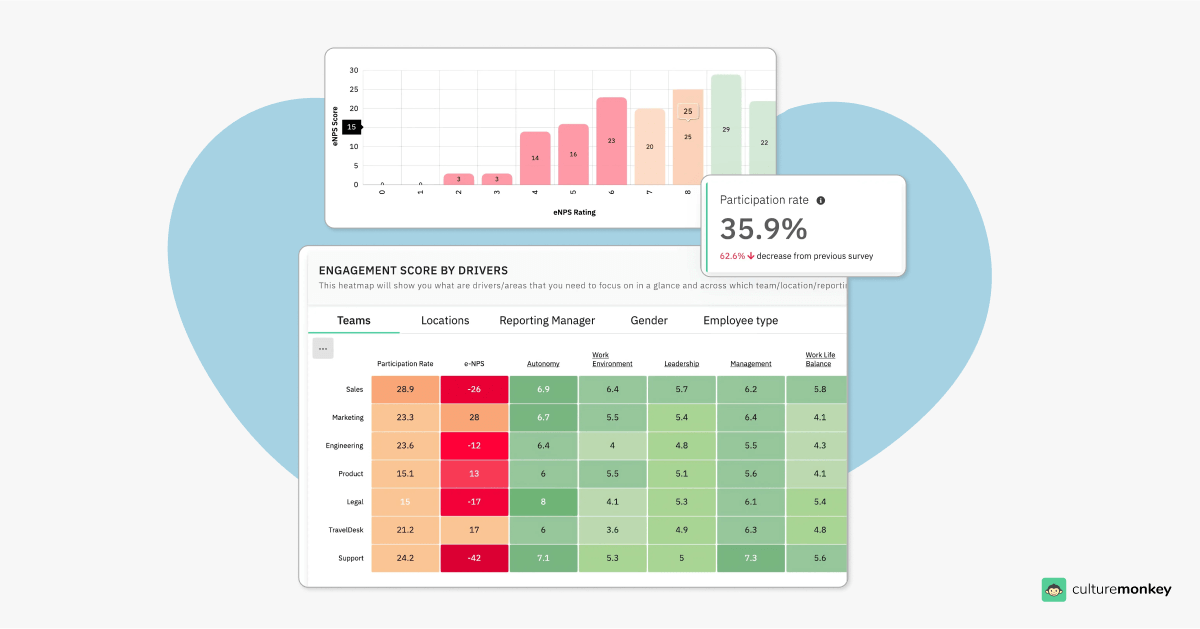
- Drill down into specific survey questions: Delve deeper into individual survey questions to analyze responses and uncover specific engagement drivers. This granular analysis helps pinpoint precise areas for improvement, allowing for targeted interventions that address underlying issues effectively.
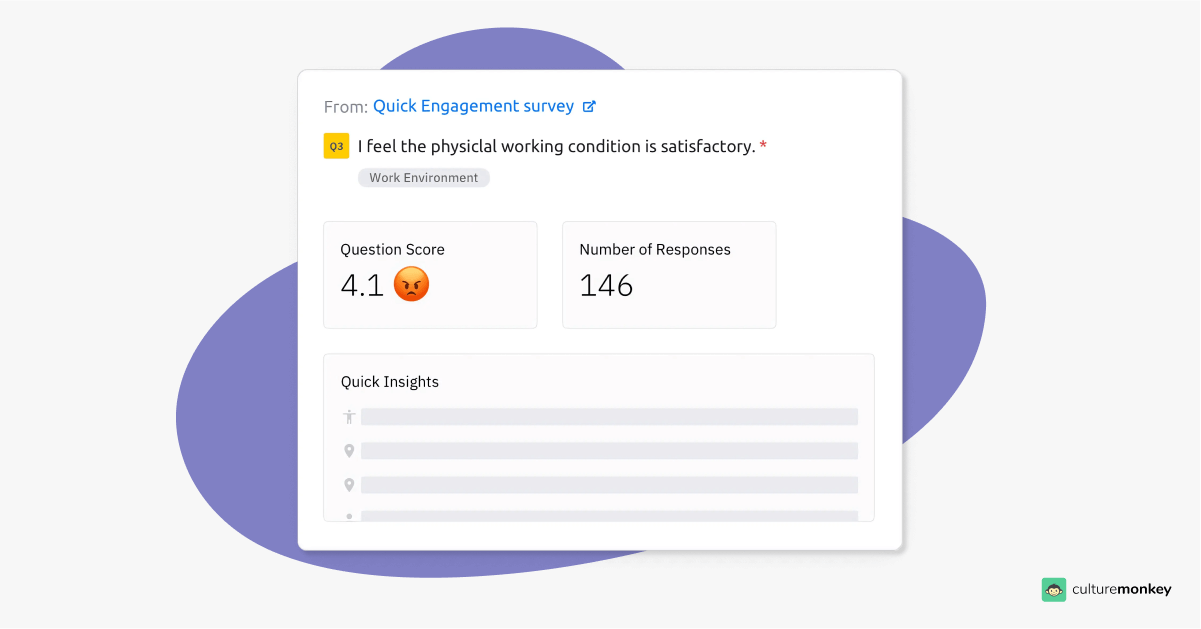
- Real-time employee feedback feed: Stay connected with real-time employee feedback through CultureMonkey's continuous feedback feed. This enables you to ensure timely responses to employee concerns, fostering a culture of openness and responsiveness that enhances trust and engagement.
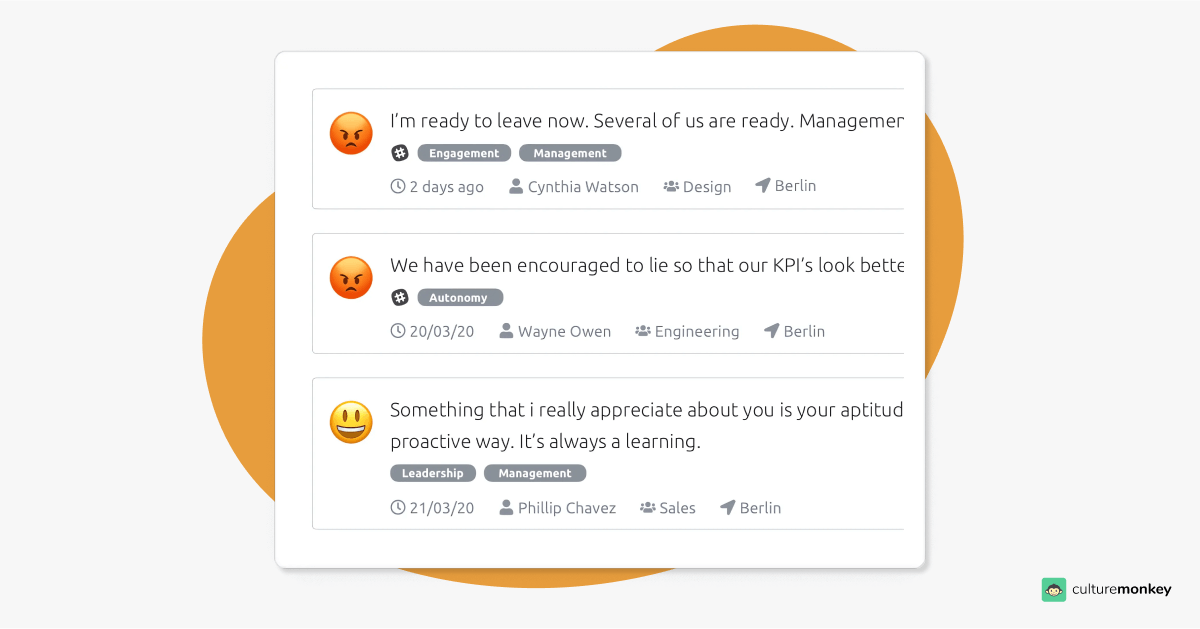
- Visualizing employee sentiments with a Word Cloud: Utilize the feedback word cloud to gain a visual representation of common themes and sentiments expressed by employees. This tool highlights prevalent topics, enabling organizations to quickly grasp the collective mood and address prominent issues.
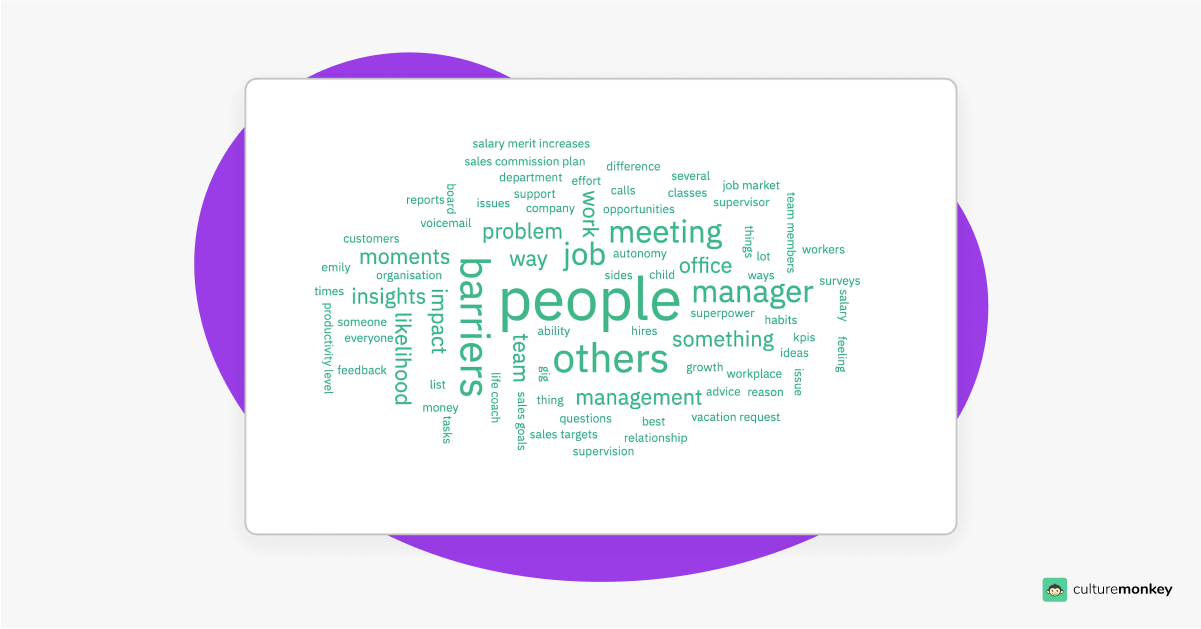
- Optimizing workplace culture through engagement measurement: CultureMonkey emphasizes the importance of accurate engagement measurement as the foundation for continuous improvement. By providing precise analytics, it empowers organizations to implement strategies that optimize workplace culture and employee satisfaction.
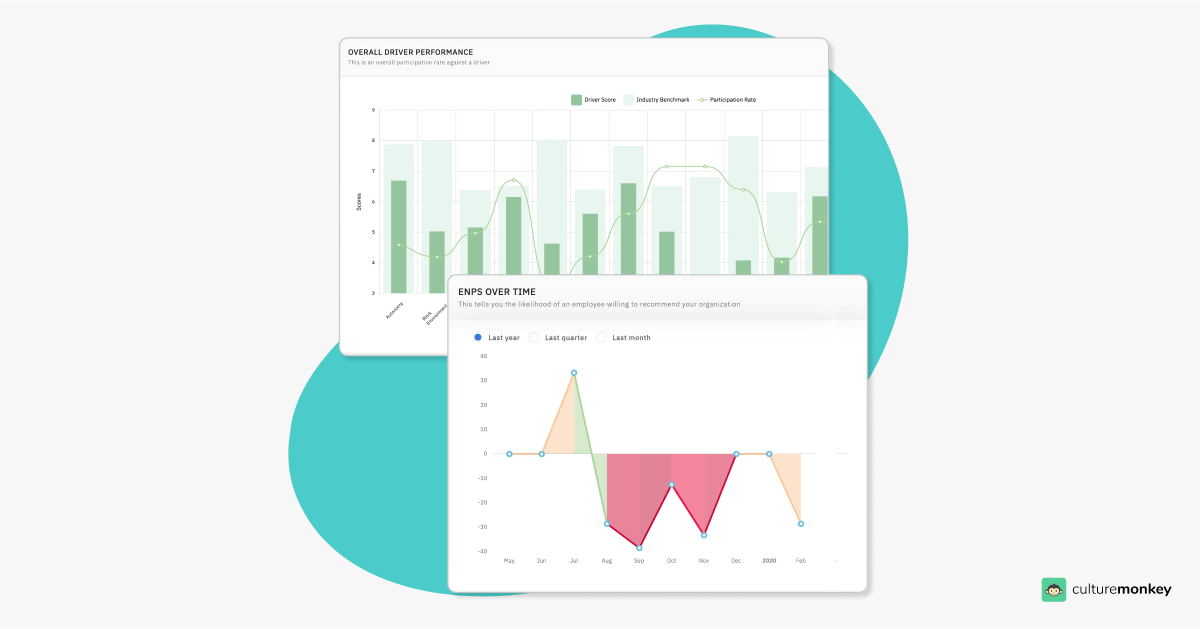
- Benchmarking engagement scores against industry standards: Measure your organization's engagement scores against industry benchmarks to understand relative performance. This comparison identifies strengths and areas for growth, guiding efforts to align with or surpass industry standards.
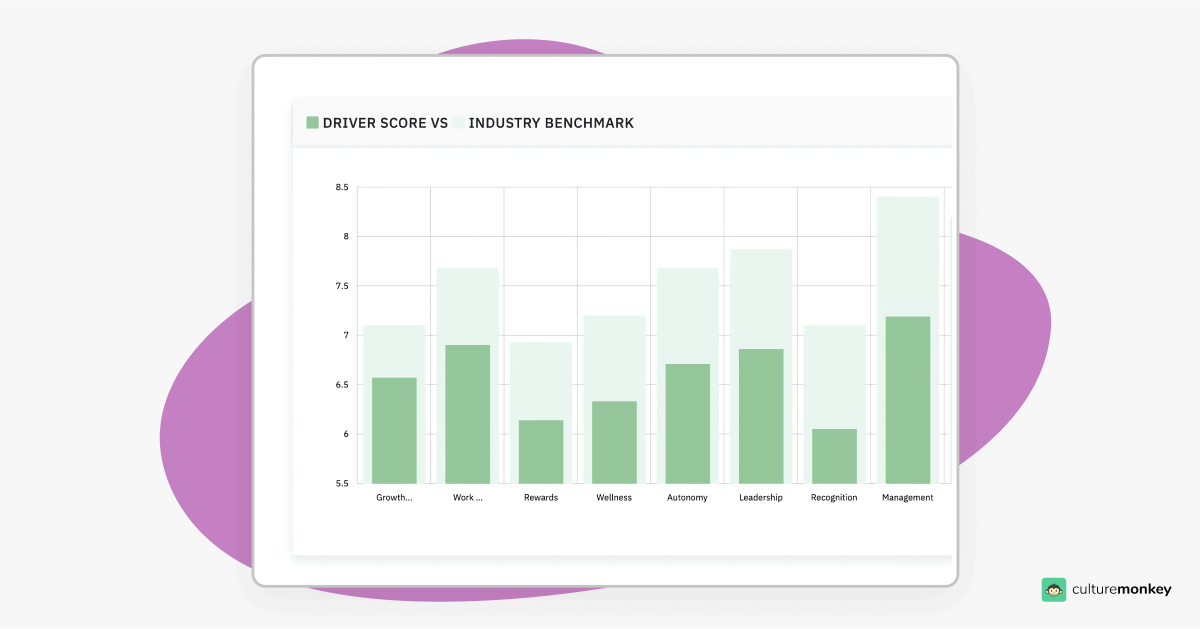
- Executive-level engagement reporting for accessible insights: CultureMonkey offers executive-level reports that distill complex survey data into accessible insights. These reports facilitate strategic discussions among leadership, ensuring that engagement metrics inform organizational decisions and policies effectively.
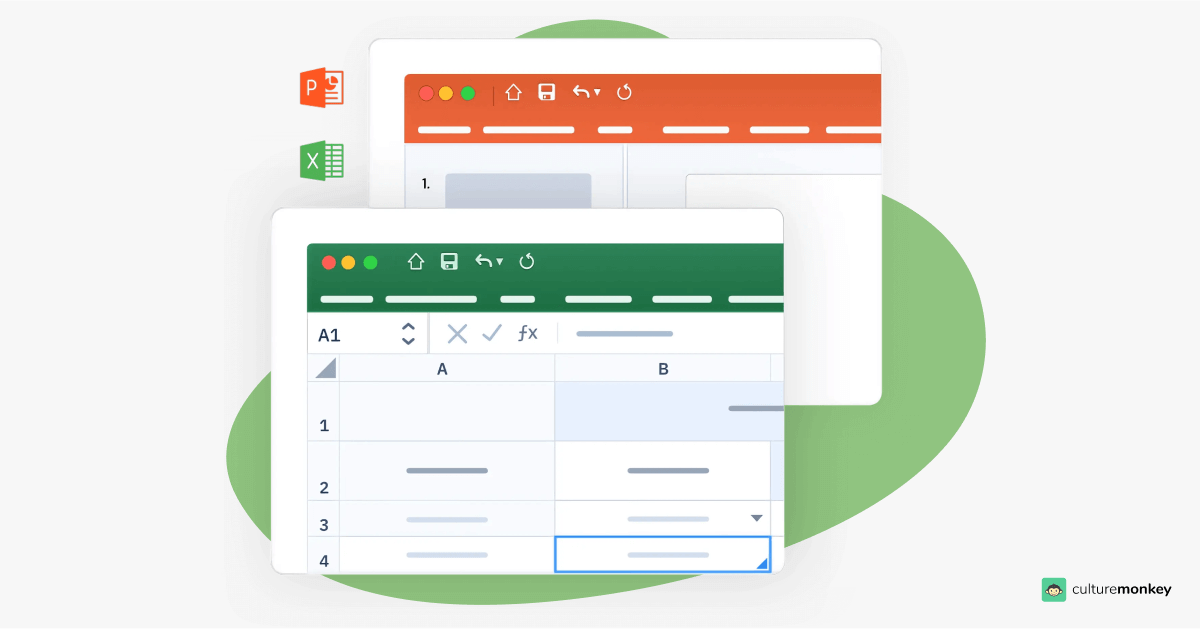
Conclusion
Interpreting employee engagement survey results goes beyond just crunching numbers; it demands a thoughtful, holistic approach. This means delving into qualitative feedback and understanding the factors shaping employee attitudes.
Effective interpretation isn't about a "magic number" but about grasping the unique organizational dynamics driving engagement. This continuous focus fosters a culture of satisfaction, commitment, and growth.
Why go halfway when you can go all the way? Enter CultureMonkey—one of the best among employee survey tools for employee engagement surveys. Powered by advanced AI technology, CultureMonkey elevates survey effectiveness through transparency, personalization, and real-time insights—all delivered in an intuitive, user-friendly platform.
With CultureMonkey, you can harness the true potential of engagement data and watch your organizational culture and employee satisfaction soar to new heights.
Summary
Employee engagement surveys are vital for assessing workforce satisfaction, commitment, and motivation. By gathering structured feedback on areas such as job satisfaction, communication, growth opportunities, recognition, and leadership effectiveness, these surveys provide actionable insights into organizational health.
Analyzing the results allows organizations to identify strengths, address challenges, and develop targeted strategies to boost engagement. Regularly conducting these surveys promotes a culture of trust, transparency, and continuous improvement, ultimately enhancing productivity, reducing turnover, and fostering a more engaged workforce.
FAQs
1. What does it probably mean if you have consistently low scores on an employee engagement survey?
Consistently low engagement scores often indicate underlying issues such as poor leadership, lack of recognition, limited growth opportunities, or low trust in the organization. It reflects disengaged employees who may feel undervalued, unmotivated, or unheard. This signals a need for deeper analysis, transparent communication, and targeted initiatives to address root causes and create a more positive work environment.
2. What do employee engagement surveys measure?
Employee engagement surveys measure how connected and committed employees feel toward their organization, their work, and its values. These surveys typically assess job satisfaction, communication effectiveness, leadership quality, workplace culture, growth opportunities, recognition, and overall employee morale. The goal is to understand employee sentiment, uncover areas of strength, and identify gaps that may be hindering engagement and productivity.
3. How often should employee engagement survey results be reviewed?
Employee engagement survey results should be reviewed regularly to track trends and ensure timely responses. Typically, annual or biannual reviews are common for comprehensive surveys. However, pulse surveys—shorter, more frequent check-ins—can be conducted quarterly or monthly to maintain a continuous understanding of engagement levels, gauge evolving employee sentiments, and promptly address emerging issues with targeted interventions.
4. How do we ensure anonymity while addressing specific feedback?
To ensure anonymity while addressing specific feedback, use aggregated data and anonymized comments without identifying individual employees. Confidential third-party survey tools can collect responses, and group feedback can be discussed without singling out contributors. Emphasizing confidentiality and transparency builds trust, encouraging candid and open feedback while enabling the organization to act on it constructively.
5. Who should be involved in developing action plans from survey results?
Developing action plans from survey results should involve a cross-functional team, including HR, managers, and senior leadership. Employee representatives or focus groups can also provide valuable input, ensuring initiatives reflect diverse perspectives. Collaborative involvement helps create practical, targeted solutions, aligns actions with organizational goals, and demonstrates a commitment to listening and improving workplace culture.
6. How do I analyze open-ended responses from surveys?
To analyze open-ended survey responses, start by reading through all feedback to identify recurring themes or sentiments. Group similar comments into categories and look for patterns and frequency to prioritize issues. Highlight impactful quotes to illustrate key points. Use these insights alongside quantitative data to guide your employee survey results action plan and communicate findings effectively.
7. Should I share employee survey results with my team?
Yes, share employee survey results with your team to foster transparency, trust, and engagement. Communicate both positive findings and areas for improvement, showing feedback matters. Use a clear, judgment-free approach and outline next steps. Sharing results encourages dialogue, builds accountability, and helps employees feel included in shaping meaningful changes based on the survey insights.
8. What happens after survey results are collected?
After survey results are collected, analyze data to identify key themes, trends, and priorities. Prepare a clear employee engagement survey presentation to share findings with leadership and employees. Communicate results transparently, then create an actionable plan addressing concerns. Follow up regularly to track progress, adjust strategies, and show employees their feedback leads to meaningful improvements.
9. What are the 5 C's of employee engagement?
The 5 C’s of employee engagement are Connection, Communication, Career, Clarity, and Contribution. Employees feel engaged when they’re connected to their team, have open communication, see career growth opportunities, understand clear goals, and feel their work contributes to organizational success. Focusing on these areas helps improve employee satisfaction survey results and strengthens overall engagement across the organization.

